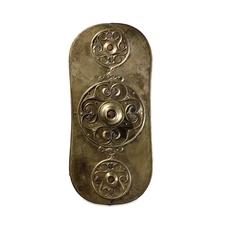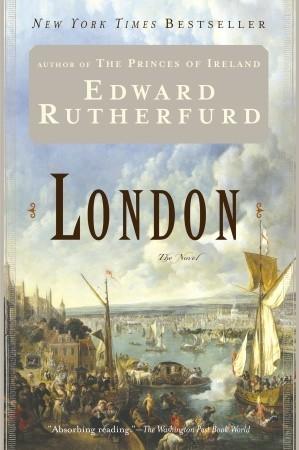Book: London by Edward Rutherfurd
Genre: Historical fiction
Publisher: Ballantine Books
Publication date: 1997
Pages: 1124
Source: Purchased paperback
Summary: London, like Edward Rutherfurd’s other books (I’ve read Paris, Sarum, and Ireland Awakening), covers the city over a time sweep of centuries. Some characters are recognizable as descendants of previous characters, but others are introduced as time goes along. A few characters are historical, but they tend to play a minor role in the events of the book which is much more about the ordinary people of London.

Battersea Shield, image from The British Museum
The novel begins with the dramatic ceremony that involved hurling the Battersea Shield into the Thames (where it would, one day, be recovered and recognized as one of the finest pieces of extant Celtic art work). We see the Roman organization of the city of Londinium followed by the Saxon take-over with their Norse gods who gave their names to the days of the week. We spent quite a long time building the Tower of London and met some of the most intriguing characters in the book, including little much-abused Osric who found clever ways to get back at the conquerors.
Much later, we witness the rise of Puritanism and the desire to emigrate to the purity of a New World, while attempting to eliminate impurities in the old world — like those distressing plays by William Shakespeare and his ilk. We experience the Great Plague and the Great Fire (events I was already familiar with after reading Quicksilver by Neal Stephenson) and the rebuilding of St. Paul’s Cathedral under the direction of Christopher Wren.

Historical fiction that goes from pre-history to modern times with lots of interesting stops in between.
Thoughts: I plastered this book with post-it notes — that’s unusual for me for fiction, but I wanted these stories to lend a richness to some of the sites that I’ll see when we visit London.
I was moved by some of the passages describing the building of St. Paul’s Cathedral. My interest in bell-ringing in England stemmed from this passage, about witnessing a celebration from the top of the dome of St. Paul’s:
But more and more bells were joining in — single bells, peals of bells, tolling and clanging with that manly clamour that only the bells of England make. For the glory of English bell-ringing is not as in other countries its tunefulness, but, on the contrary, the stern order of the permutations, as the bells are led through their changes, as strict as the mathematics of the heavens. p. 851
I’ve done some research so that I know where to go hear bells ring each Sunday morning of our trip and, even, one Tuesday evening when I hope to hear a rehearsal.
We will enter London from Birmingham at Euston Station, just as the industrialists of the Midlands did to attend the Great Exhibition of 1851:
If the stagecoaches could carry ten passengers along the turnpikes at, perhaps, eight miles an hour, the carriages rattling along the iron tracks behind a steam locomotive could take a hundred people at forty miles an hour. It was the steam trains that had brought people from far and wide to the Great Exhibition in the Crystal Palace. Without the new trains, most of those from the provinces could not possibly have come. p. 989
Of course, we won’t take a steam-powered train into London. We will take a ride on one, however, as a day trip from Birmingham — at the Severn Valley Railway.
A couple of scenes in London explained the significance of the Cutty Sark clipper ship, the last hurrah of the sailing ships before the mechanized ones took over the waves. We’ll visit the Cutty Sark during our day in Greenwich.
I loved that the last chapter, in modern times, was about an archaeologist working for the Museum of London. The Museum of London will be the featured stop of our itinerary on our first full day in the City.
Appeal: London is a massive book for people who love history, England, and settling in for a long time with a good book.
 Challenges: London is my second book for the 2014 Chunkster Reading Challenge. At 1127 pages, it could count as two chunksters and still have pages left over! I challenged myself to read four chunksters this year. I’m bringing two with me on my trip to England (that way I don’t have to worry about running out of things to read), so I’m confident that I’ll complete this challenge.
Challenges: London is my second book for the 2014 Chunkster Reading Challenge. At 1127 pages, it could count as two chunksters and still have pages left over! I challenged myself to read four chunksters this year. I’m bringing two with me on my trip to England (that way I don’t have to worry about running out of things to read), so I’m confident that I’ll complete this challenge.
London also counts as my seventh book for the British History Reading Challenge, over twice as many as I committed to — and I’m not done yet!
I’ll link this review tomorrow with this week’s British Isles Friday.
Have you read this book? What did you think?

